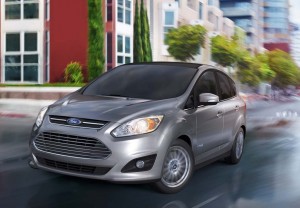Ford has been taking aggressive aim at Toyota this year and borrowing a page from the Japanese giant’s playbook in the process, focusing not only on new battery-powered models like the Fusion Hybrid and C-Max but also by bragging that some of Ford’s newest offerings deliver better mileage than the Toyota alternatives?
The latest salvo follows the EPA’s official assessment of the Ford C-Max Energi, the plug-in version of the new “people mover.” Despite being the size of the larger Prius V, the EPA has rated the C-Max Energi at 108 miles per gallon in city driving and 100 in the highway and combined measurements. That’s 5 mpg better than the smaller Toyota Prius Plug-in, a version of the original member of the new Prius “family.”
But will potential buyers care?
So far, Ford has had only modest success in the battery-electric market. While Toyota currently produces about half of all battery-based models sold in the U.S., Ford’s market share has slipped by more than half over the last year to barely 4%.
That decline is a bit misleading, however. It is largely the result of eliminating the old Ford Escape Hybrid model – the 2013 version swapping that hybrid driveline for a nearly as efficient EcoBoost system. That alone drove Ford’s share of the battery-based market down from 9.5% last year.
But rolling into the 2013 model-year, Ford is now ramping up its electrification program. It is adding both a “conventional” hybrid version of the C-Max and the new C-Max Energi. There will be a hybrid version of the new Ford Fusion and a plug-in Ford Fusion Energi. There’s a new battery-electric version of the Focus, as well, though like Toyota’s new RAV4-EV, it will be offered in a limited number of markets, at least initially.
The challenge, Ford officials have acknowledged, is two-fold. First, the maker has to build up its brand image in traditionally import-oriented markets, especially along the coasts. That’s particularly true in California, the place where buyers have been most charged up by battery power – and where the Golden State’s regulators have been dangling both carrot and stick.
The original Prius sales surge was driven, at least in part, by the availability of special stickers permitting Californians to drive solo in the state’s coveted HOV lanes, sometimes shaving an hour of commute time daily. The law was recently changed, eliminating standard hybrids but now covering plug-ins and pure battery-electric vehicles, or BEVs.
That has helped boost demand for the new Prius Plug-In, industry watchers suggest. And the numbers support that. While the Prius Plug-In is currently available in 15 states, California sales overwhelmingly dominate – and helped drive demand up to 1,652 during September, making it the second best-selling model among all so-called “advanced” battery vehicles, a term that covers plug-ins and BEVs.
That puts the Prius Plug-In second only to the Chevrolet Volt plug-in when it comes to overall sales this year, 7,734 to 16,348 during the first nine months of 2012 – all the more significant since the Toyota model wasn’t available until spring.
Skeptics have taken shots at the Prius Plug-In, however, dubbing it a so-called “compliance car,” designed primarily just to meet tough new rules enacted by the California Air Resources Board. At barely 13 miles per charge, barely 40% of what the Chevy Volt gets, they question its real-world impact on gas consumption. But a lower price tag and the HOV sticker have overcome any such concerns.
Ford’s C-Max will have a more useful 20 mpg range on battery power – though still a lot less than the Volt, Ford officials insist that will be much more realistic for daily commuting, covering the drive for as many as half of all American commuters.
And the 108 mpg highway rating will add another arrow to Ford’s marketing quiver.
A week ago, Ford gave a hint of its plans when it announced it will pitch the C-Max as a higher-mileage alternative to the Prius. The standard hybrid will go up against the bigger Prius V and the C-Max Energi will take aim at the Prius Plug-In.
“It’s a direct comparison. Prius is so swell understood by customers. Toyota has done such a good job with hybrids. So it makes sense for us to compare C-Max to Prius,” explained Jim Farley, Ford’s global marketing chief – who also happened to be a major marketing strategist at Toyota before heading to Detroit in 2007.
The $26,000 hybrid version of the C-Max began reaching dealers in small numbers in September, nonetheless rolling up about 1,000 sales. But that’s a far cry behind dominant Prius. It remains to be seen if the C-Max Energi will charge into the market faster in its bid to overtake the Prius Plug-In.
Ford isn’t counting on C-Max alone. It recently began pitching the advantages of its Fusion Hybrid which will deliver as much as 8 mpg more than the Toyota Camry Hybrid.
Ford needs to gain momentum. It recently announced plans to add more than 1,000 staff to its new electrification center at the sprawling product development complex near its headquarters in the Detroit suburb of Dearborn.
Ford had been promising to have as many as five different advanced battery models on the road over the next two years but is hinting it will offer even more by then – with a significant expansion of that line-up to follow. The real question is if Ford builds them, will buyers come?

